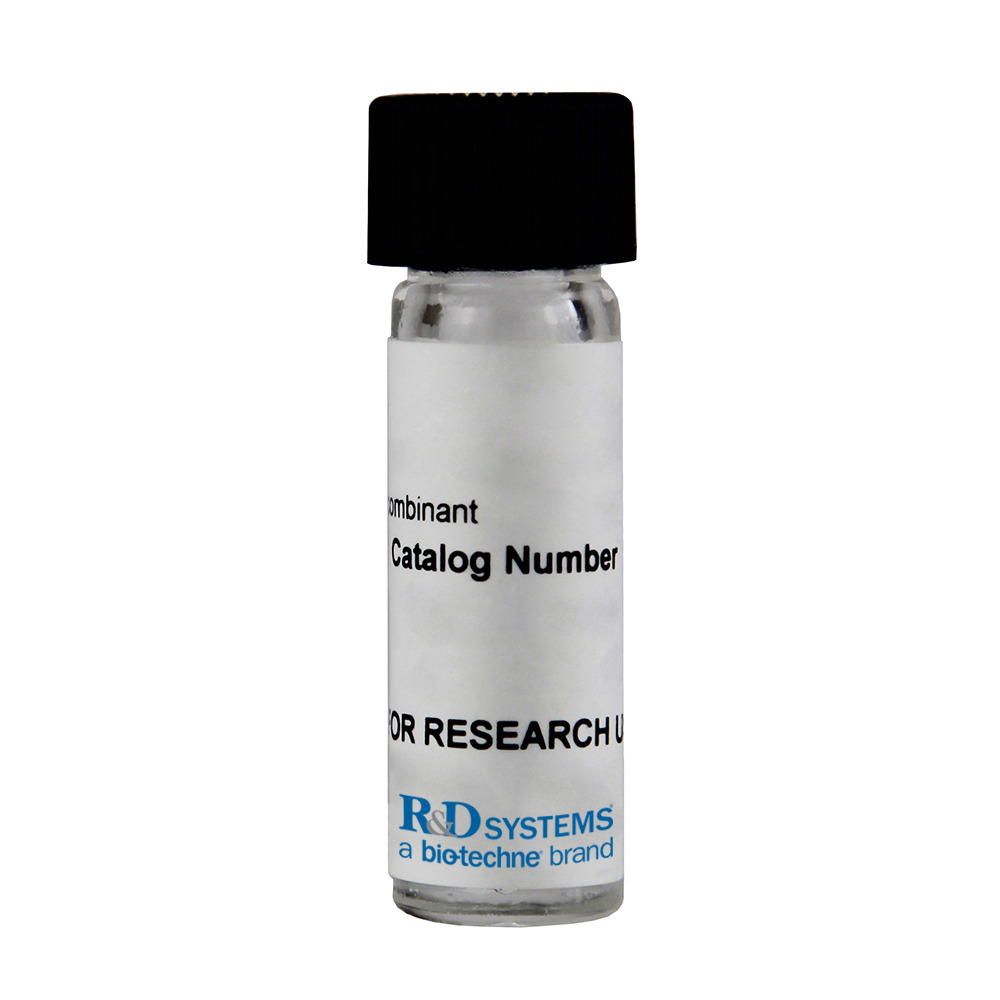Human DR6/TNFRSF21 Antibody Summary
Gln42-Leu350
Accession # O75509
Customers also Viewed
Applications
Human DR6/TNFRSF21 Sandwich Immunoassay
Please Note: Optimal dilutions should be determined by each laboratory for each application. General Protocols are available in the Technical Information section on our website.
Preparation and Storage
- 12 months from date of receipt, -20 to -70 °C as supplied.
- 1 month, 2 to 8 °C under sterile conditions after reconstitution.
- 6 months, -20 to -70 °C under sterile conditions after reconstitution.
Background: DR6/TNFRSF21
Death Receptor 6 (DR6), also known as TNFRSF21 and CD358, is a type I transmembrane protein in the TNF receptor superfamily (1). Human DR6 consists of a 308 amino acid (aa) extracellular domain (ECD) with four cysteine‑rich motifs, a 21 aa transmembrane segment, and a 285 aa palmitylated cytoplasmic region that contains one death domain (2, 3). Within the ECD, human and mouse DR6 share 82% aa sequence identity. DR6 is expressed as an approximately 110 kDa molecule that carries extensive N‑linked and O‑linked glycosylation in its extracellular region (3, 4). Among hematopoietic cells, DR6 is expressed on monocytes, resting CD4+ T cells, and pro‑, pre‑, and naïve B cells (5 ‑ 7). DR6 knockout mice exhibit a Th2‑biased immune response characterized by exaggerated Th2 and B cell responsiveness in combination with reduced Th1 cell responsiveness and inflammatory leukocyte infiltration (6 ‑ 9). DR6 knockout mice are resistant to induced airway inflammation and experimental autoimmune encephalitis but more susceptible to severe graft versus host disease (9 ‑ 11). DR6 is also expressed on developing neurons where it can bind a shed 35 kDa N‑terminal fragment of APP or a fragment of APLP2 (12, 13). This APP fragment is generated following deprivation of neurotrophic factors, and its binding to DR6 triggers DR6‑mediated axonal pruning (12). DR6 is constitutively expressed on some prostate cancer cells and can be induced by TNF‑ alpha on others (3, 4).
- Benschop, R. et al. (2009) Adv. Exp. Med. Biol. 647:186.
- Pan, G. et al. (1998) FEBS Lett. 431:351.
- Klima, M. et al. (2009) Biochim. Biophys. Acta 1793:1579.
- Kasof, G.M. et al. (2001) Oncogene 20:7965.
- Matesanz-Isabel, J. et al. (2011) Immunol. Lett. 134:104.
- Schmidt, C.S. et al. (2003) J. Exp. Med. 197:51.
- Liu, J. et al. (2001) Immunity 15:23.
- Zhao, H. et al. (2001) J. Exp. Med. 194:1441.
- Venkataraman, C. et al. (2006) Immunol. Lett. 106:42.
- Schmidt, C.S. et al. (2005) J. Immunol. 175:2286.
- Liu, J. et al. (2002) J. Immunol. 169:3993.
- Nikolaev, A. et al. (2009) Nature 457:981.
- Kuester, M. et al. (2011) J. Mol. Biol. 409:189.
Product Datasheets
Citations for Human DR6/TNFRSF21 Antibody
R&D Systems personnel manually curate a database that contains references using R&D Systems products. The data collected includes not only links to publications in PubMed, but also provides information about sample types, species, and experimental conditions.
2
Citations: Showing 1 - 2
Filter your results:
Filter by:
-
MicroRNA-195 prevents dendritic degeneration and neuron death in rats following chronic brain hypoperfusion
Authors: X Chen, XM Jiang, LJ Zhao, LL Sun, ML Yan, Y Tian, S Zhang, MJ Duan, HM Zhao, WR Li, YY Hao, LB Wang, QJ Xiong, J Ai
Cell Death Dis, 2017-06-01;8(6):e2850.
Species: Rat
Sample Types: Tissue Homogenates
Applications: Western Blot -
Sensitization of imatinib-resistant CML cells to TRAIL-induced apoptosis is mediated through down-regulation of Bcr-Abl as well as c-FLIP.
Authors: Park SJ, Kim MJ, Kim HB, Kang CD, Kim SH
Biochem. J., 2009-04-28;420(1):73-81.
Species: Human
Sample Types: Whole Cells
Applications: Flow Cytometry, Neutralization
FAQs
No product specific FAQs exist for this product, however you may
View all Antibody FAQsReviews for Human DR6/TNFRSF21 Antibody
There are currently no reviews for this product. Be the first to review Human DR6/TNFRSF21 Antibody and earn rewards!
Have you used Human DR6/TNFRSF21 Antibody?
Submit a review and receive an Amazon gift card.
$25/€18/£15/$25CAN/¥75 Yuan/¥2500 Yen for a review with an image
$10/€7/£6/$10 CAD/¥70 Yuan/¥1110 Yen for a review without an image








